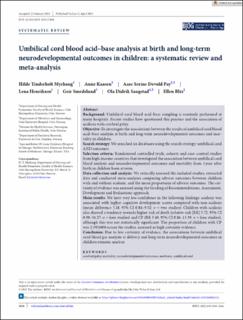| dc.contributor.author | Myrhaug, Hilde Tinderholt | |
| dc.contributor.author | Kaasen, Anne | |
| dc.contributor.author | Pay, Aase Serine Devold | |
| dc.contributor.author | Henriksen, Lena | |
| dc.contributor.author | Smedslund, Geir | |
| dc.contributor.author | Saugstad, Ola Didrik | |
| dc.contributor.author | Blix, Ellen | |
| dc.date.accessioned | 2024-02-02T10:04:15Z | |
| dc.date.available | 2024-02-02T10:04:15Z | |
| dc.date.created | 2023-06-10T09:34:23Z | |
| dc.date.issued | 2023 | |
| dc.identifier.citation | BJOG: An International Journal of Obstetrics and Gynaecology. 2023, 130 (10), 1156-1166. | en_US |
| dc.identifier.issn | 1470-0328 | |
| dc.identifier.uri | https://hdl.handle.net/11250/3115234 | |
| dc.description.abstract | Background: Umbilical cord blood acid–base sampling is routinely performed at
many hospitals. Recent studies have questioned this practice and the association of
acidosis with cerebral palsy.
Objective: To investigate the associations between the results of umbilical cord blood
acid–base analysis at birth and long-term neurodevelopmental outcomes and mor-
tality in children.
Search strategy: We searched six databases using the search strategy: umbilical cord
AND outcomes.
Selection criteria: Randomised controlled trials, cohorts and case–control studies
from high-income countries that investigated the association between umbilical cord
blood analysis and neurodevelopmental outcomes and mortality from 1 year after
birth in children born at term.
Data collection and analysis: We critically assessed the included studies, extracted
data and conducted meta-analyses comparing adverse outcomes between children
with and without acidosis, and the mean proportions of adverse outcomes. The cer-
tainty of evidence was assessed using the Grading of Recommendations, Assessment,
Development and Evaluations approach.
Main results: We have very low confidence in the following findings: acidosis was
associated with higher cognitive development scores compared with non-acidosis
(mean difference 5.18, 95% CI 0.84–9.52; n = two studies). Children with acidosis
also showed a tendency towards higher risk of death (relative risk [RR] 5.72, 95% CI
0.90–36.27; n = four studies) and CP (RR 3.40, 95% CI 0.86–13.39; n = four studies),
although this was not statistically significant. The proportion of children with CP
was 2.39/1000 across the studies, assessed as high certainty evidence.
Conclusion: Due to low certainty of evidence, the associations between umbilical
cord blood gas analysis at delivery and long-term neurodevelopmental outcomes in
children remains unclear. | en_US |
| dc.language.iso | eng | en_US |
| dc.rights | Navngivelse 4.0 Internasjonal | * |
| dc.rights.uri | http://creativecommons.org/licenses/by/4.0/deed.no | * |
| dc.title | Umbilical cord blood acid–base analysis at birth and long-term neurodevelopmental outcomes in children: a systematic review and meta-analysis | en_US |
| dc.type | Peer reviewed | en_US |
| dc.type | Journal article | en_US |
| dc.description.version | publishedVersion | en_US |
| cristin.ispublished | true | |
| cristin.fulltext | original | |
| cristin.qualitycode | 2 | |
| dc.identifier.doi | 10.1111/1471-0528.17480 | |
| dc.identifier.cristin | 2153421 | |
| dc.source.journal | BJOG: An International Journal of Obstetrics and Gynaecology | en_US |
| dc.source.volume | 130 | en_US |
| dc.source.issue | 10 | en_US |
| dc.source.pagenumber | 1156-1166 | en_US |

